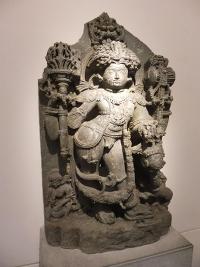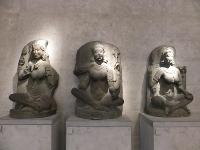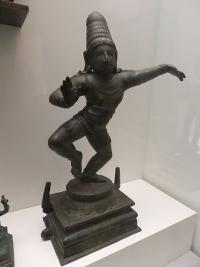***
France/Spain 2011
Day 5 - 21st March - Paris: Musée Guimet - India (Part 5)



Bodhisattva Khasarpana-Lokesvara, Bengal. End of 11th-Start of 12th c.


Vishnu Caturmurti, Kashmir. 12th c.

The Musée Guimet on varnas (classes) vs jati (castes), which it claims are different

Siva and his Linga (penis)
Also this funny story:
"Brahma and Visnu were arguing about which of them was the Supreme Divinity when a column of fire appeared to quell their pride. They decided that he who discovered one of its extremities would be superior to the other. Brahma and Visnu, metamorphosed respectively into a bird and a boar, set out to do this but neither succeeded. Finally, Siva emerged from the pillar, thereby compelling Brahma and Visnu to recognise his superiority"



Goddess. Rajastan. 10th c.



Ekamukhalinga, linga with divine face. Bihar, End of 7th-Start of 8th c.
I will let the Met explain this one:
"The linga (phallic emblem of Shiva) symbolizes the great generative force of the universe. It is usually the most sacred object in a temple dedicated to Shiva and is housed in the main sanctum. When plain (simply phallic), the linga represents Shiva in his most abstract form. In this example, Shiva's face has emerged"


Bhairava, terrible form of Siva. Karnataka. 13th c.


Three Granite Yogini. End of 9th/Early 10th c.



Visnu Narayana lying on serpent of Eternity, Ananta. Tamil Nadu. 17th-18th c.



Siva Vyakhyanadaksinamurti, Master of Knowledge. Tamil Nadu. 12th-13th c.


Kali's terrible form. Tamil Nadu. 14th-15th c.



Siva Nataraja, Lord of the Dance. Tamil Nadu. 11th c.
Here Shiva is engaging in one of his five Fundamental Activitie: dancing. Specifically, on the Dwarf of Evil/Ignorance.
Since you asked, according to About Hinduism the five Fundamental Activities are 'Shrishti' (creation, evolution); 'Sthiti' (preservation, support); 'Samhara' (destruction, evolution); 'Tirobhava' (illusion); and 'Anugraha' (release, emancipation, grace). I'm guessing this one here is Samhara.
I am now expecting letters from the Dwarves' Association complaining about stereotyping.


Ayyanar, Village God protecting the lands and the fields. Kerala. 14th-15th c.


Ritual Lamp. Kerala. 17th-18th c.



Siva Kevala-Candrasekharamurti. Tamil Nadu. End of 12th-13th c.


Siva Umasahitamurti. Tamil Nadu. 13th-14th c.


Yoga-Narasimha, avatara of Vishnu, as a Man-Lion. Tamil Nadu. 12th-13th c.


Dancing Balakrisna. Tamil Nadu. 11th-12th c.
It will come as no surprise that Tamil Nadu was part of French India.



The Goddess Kali. Tamil Nadu. 12th c.


Elephant goad (ankusa). Tanjore or Mysore. 17th c:
"The elephant goad or Aṅkuśa (Sanskrit) is a tool employed in the handling and training of elephants, the largest land animals. It consists of a hook (usually bronze or steel) which is attached to a 60 - 90 cm (two- or three-foot) handle. The hook is inserted into the elephant's sensitive skin, either slightly or more deeply, to cause pain and induce the elephant to behave in a certain manner"


Decorative Door Panels. Tamil Nadu/Madurai. 17th c.


Head and child in the shape of a bird. Virampatnam-Arikamedu. 1st-2nd c.


Souttoukeny: Jewelry. 2th c. BC



Yaksi, Goddesses of Fertility, Chandraketugarh, 2th-1st c. BC.


Various votive figures